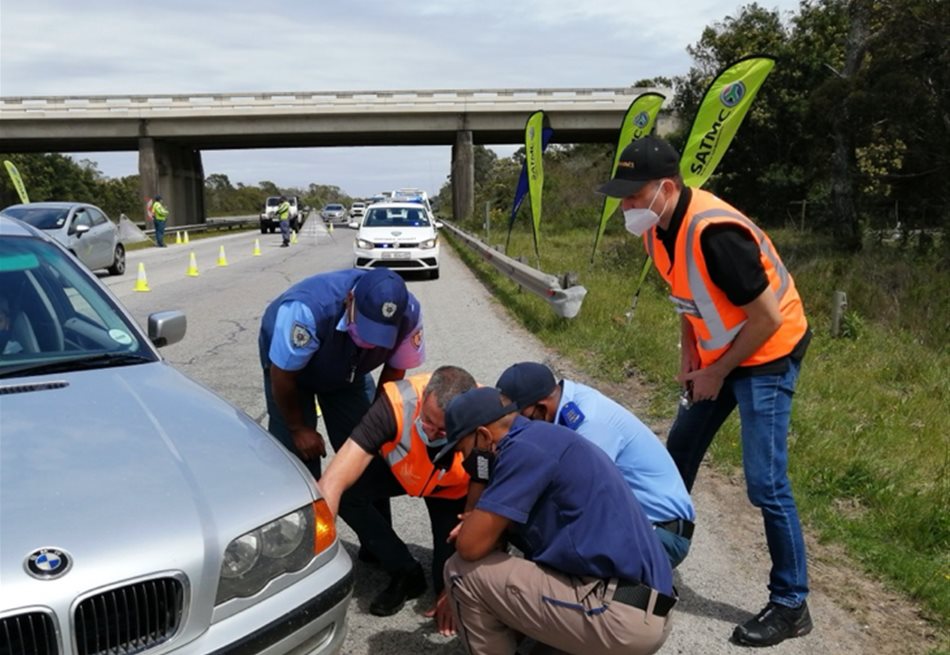“As the festive season approaches, we see a significant increase in road accidents each year,” says the Road Accident Fund spokesperson, William Maphutha. “Many of these could be avoided by ensuring one’s car is safe and roadworthy for travel,” he adds.
“Because tyres play a significant role in the safety of a vehicle, we’ve partnered with the RAF to educate and reinforce South Africa’s tyre laws by conducting these workshops and commuter educational roadblocks,” explains Nduduzo Chala, managing executive of the SATMC.

Law enforcement providing free tyre checks during a commuter roadblock held on the N2 near Seaview Road exit, Gqeberha.
The tyre safety workshop was held at the Nelson Mandela Bay Traffic College. The training was conducted by Lance Williams, technical manager at Continental Tyres, and covered three key elements of tyre safety, listed below. Law enforcement then educated consumers on these three elements and provided free tyre checks during a commuter roadblock held the next day.
1. Ensuring your tyre pressure is correct
“Your tyres should always be inflated to the level indicated on the inside of the driver’s door. If there is no sticker on the door, you can usually find the specs in the owner’s manual,” explains Chala. It is essential to check your tyres and know your recommended inflation levels so as not to overload your tyres. Underinflated tyres may cause tyre failure because of movement in the tyre sidewall. Overinflated tyres may decrease traction on the road, giving you a bouncy ride and an ill-handling car.
2. Checking that the tread depth is not less than 1.6 mm
“More tread means more grip, especially in wet conditions. It’s as simple as that,” says Chala. “Tread depth plays an essential role in vehicle control and braking distances. It is important to check the tread depth across the entire width of the tyre as the outer tread may be deeper than the inner,” he adds.
The tread depth can be checked with a dedicated tread gauge or by using the built-in Tread Wear Indicator (TWI) on your tyres. The TWI is a small rubber insert set at 1.6mm in the grooves of your tyre. Look for a small arrow on the tyre’s sidewall with the letters’ TWI’ to indicate where they are situated. They show how much of the tyre has already rubbed off and if the tyre is worn out. The tyre must be replaced if the tread is at the same level as the TWI.
3. Second-hand tyre checks
“More than 60% of second-hand tyres sold in South Africa are illegal,” says Chala. “Second-hand tyres are a cheaper alternative when replacing your car’s tyres, but due diligence needs to be taken to ensure that these tyres are, in fact, still roadworthy and safe to drive,” he adds.
A second-hand tyre is not safe to use when:
- The tread depth across any part of the tyre is level with the TWIs.
- There is no TWI due to carving the rubber on tyres to create more tread depth (regrooving).
- There is damaged rubber, including sidewall damage, bead damage and inner liner damage that exposes the fabric or cord.
- There are cuts, lumps, or bulges.
- You can see temporary solutions, such as tyre plugs, have been used.
“We appreciate the support of the RAF and the Eastern Cape law enforcement in educating consumers about tyre laws and the importance of tyre safety. Tyres are a safety-critical component in a vehicle. So we urge all motorists to check their tyres regularly and, if necessary, replace them with tyres from accredited/reputable tyre dealers. Having our consumers stay safe on the road during the festive season remains our top priority,” concludes Chala.
Issued by cause marketing agency, dotGood.
For more information on the SATMC and what they do, visit http://www.satmc.co.za/ or email az.oc.cmtas@ofni.
About The South African Tyre Manufacturing Conference
The SATMC is the official industry body and trade association of the local tyre manufacturers, namely Bridgestone, Continental, Goodyear and Sumitomo. They are the voice of the local tyre manufacturers and represent tyre manufacturers on trade, economic and environmental policies, tyre sector regulations. They maintain stakeholder relationships in order to drive the objectives of their members. The SATMC actively engages consumers and other stakeholders to bring awareness and empower them on road safety.
- They develop and advocate for policies, regulations and positions on behalf of the local tyre manufacturers.
- They engage in discussions and activities that further the interests of the member organisations.
- They engage with all levels of government and stakeholders to ensure sound policies and regulations that promote trade, investment and a competitive operating environment for our members.
- They are thought leaders and industry experts.
- Together with their members, they empower consumers with knowledge to ensure their safety on the roads.
